Fill your basket with products by clicking "Add to my collection" from any product page. This can be found either within the product options panel or below the product image. Collections can be saved, and stored, within your HAGS Connect account or create and print your own custom brochure, download the files you need in one go, or to request a quote.
How playground equipment supports play values and inclusive experiences
Inclusive playgrounds are places where children of all abilities can play and obtain a rich range of physical, sensory and social experiences. Here we explore how the quantity, quality, diversity and inter-relationships of play equipment and features support these play values and inclusive experiences.
What is Play Value?
The term 'Play Value' is used to describe the value an environment, object or piece of equipment brings to children's experience of play. High play value indicates children can play in many different ways, expand or elaborate on their own ideas and actions. A cardboard box can be said to have high play value as children can use it as a den, a car, to hide in, a goal, a hurdle, etc.
Play value is divided into three categories:
Each type of play is crucial to a child’s development and enjoyment of the play space; therefore, you should try to include a mixture of all three when selecting play equipment and features to create an exciting and more inclusive play space.
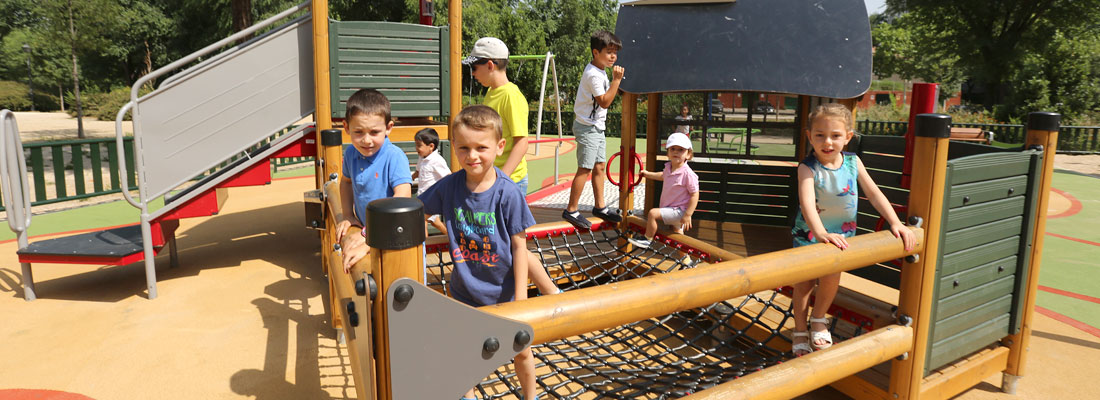
Physical Play Experience
Play activities such as spinning, sliding, rocking, swinging and climbing are all physical experiences. Learn more about how they can help a child’s development while providing them with enjoyment.
Spinning
When children spin, different parts of the brain are stimulated simultaneously. This builds new and more developed pathways throughout the brain – pathways that improve learning potential, spatial awareness, rhythm and more.
Spinning activities develop the brain in such a way that pre-reading concepts are advanced while improving balance, muscle control and gross motor skills.
Add this play value to your playground by choosing different pieces of equipment that provide children with the ability to sit and spin, stand and spin, and lie and spin. This could either be three different pieces, or one single piece could provide the ability to play in different positions, like the SpinR², which allows children to sit, stand, lay and spin.
You can also provide children with a more challenging experience by adding spinning equipment with and without hand holds.
Explore Spinners and Roundabouts
Sliding
When sliding, children experience height, movement and the thrill of speed and risk.
Slides stimulate children’s vestibular system* and sense of balance.
If possible, provide slides at different heights, as well as a wide slide so that a parent can support a child going down the slide. You can also choose different types of slides, such as, tube, textured, curved, straight, spiral, etc. to provide different experiences.
For creating a more inclusive playground, have one slide that does not create static electricity for people with a cochlear implant and provide a place for a child to sit while their wheelchair is being retrieved. Also, make sure the tallest slide is accessible.

*The sensory system that responds to the position of the head in relation to gravity and accelerated or decelerated movement.
Rocking
Rocking provides children with a fun movement and prompts imaginative play, it also challenges and develops children’s vestibular system by moving the body in a rocking motion.
Try to include at least one piece of equipment that provides a to-and-fro motion and another one that provides side-to-side motion. It’s also a good idea to provide multiple pieces of rocking equipment to support children in a variety of positions: sitting, standing and lying, but some equipment could provide multiple experiences in one.
Think about including at least one piece of rocking equipment for individual play and another for multiple children. As well as considering rockers that have adult-sized/ bigger seats to allow older children or adults to use them together with the child.
Swinging
Swinging offers a fun movement and prompts imaginative and social play, it also challenges, stimulates and develops children’s vestibular system.
Look at providing a swing that moves in a linear motion and another swing that moves in a circular motion. Also, consider a variety of swings and swing sizes, for example a belt swing, toddler swing, tyre swing, a bird nest swing, etc. so that your playground offers a choice of swings for all abilities.
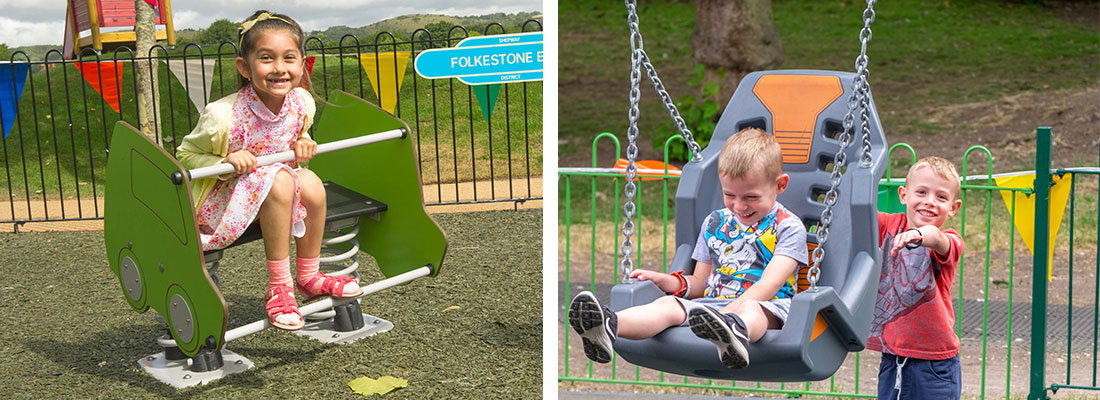
Climbing and crawling
An inclusive playground should offer the opportunity of risk and challenge, excitement and different ways of moving in order to improve motor skills such as balance, coordination, strength and dexterity.
Climbing and crawling challenge, stimulate and develop the user’s proprioceptive system*.
We have divided climbing and crawling into three challenge levels to help select a variety of experiences in this category.
Climbing
If climbing activities are selected, include at least two challenge levels, with one of them being a Level 1 piece of equipment or feature to include children who have the least strength.
Level 1: this includes equipment with a combination of any of the following characteristics:
- Low to the ground
- Low slope
- With hand holds on each side
- The ability to put the entire body on the climbing equipment to provide more support
- The path a child must take is obvious
Examples of this includes level to the ground web net, a ladder/ stair with hand holds, a low boulder, etc.
Level 2: this includes equipment with a combination of any of the following characteristics:
- Can be angled
- Have at least one way to support the body (put the full body on it, one hand only, etc.)
- Have multiple paths to reach the top, but they must be obvious, and the first step is easy to reach
Examples of this include angled rock wall, medium sized boulder with good hand or foot support, a straight up climber with even steps and good hand or foot supports, a curved climber with steps where the entire body can be on it for support.
Level 3: this includes equipment with a combination of any of the following characteristics:
- Reaches a high place
- Is vertical
- Can have a complicated or multi-way path to reach the top, supports are minimal or not obvious, is dynamic, requires great agility to accomplish
This type of equipment is normally used by the older children. Examples include large boulder with limited support, web net, vertical rock wall, etc.

*The proprioceptive system consists of sensory information caused by contraction and stretching of muscles and by bending, straightening, pulling and compression of the joints between the bones.
Crawling
Consider including at least two crawling activities that allow a child to attempt different challenge levels.
Level 1: this would be a short tunnel placed on the ground or bumpy surface.
Level 2: this would be a longer tunnel on the ground or elevated with accessible routes on either side.
Level 3: this would be a tunnel that changes elevations and opportunities to crawl between levels.
Balancing
An inclusive playground should provide a wide variety of activities that respond to children’s need for risk and challenge, while increasing their ability to balance on their feet and build core body strength.
Try to provide one balancing activity with one hand support and another one where the child can use both hands. Include at least one balancing equipment where the child can sit and stand, this could be one single piece of equipment, such as a stool.
Incorporate challenge by including one static and one dynamic balancing activity, and/or including straight and curved balancing activity options. Remember to provide equipment at ground level (this can be patterns on the surfacing) and one that is elevated with an accessible route.
Explore balance courses and trim trails
Jumping and bouncing
Jumping and bouncing are great at challenging, stimulating and developing the user’s vestibular system and proprioceptive system. It is also great fun and provides children with the feeling of flying in the air.
Provide at least one jumping or bouncing activity that can be used while sitting and another that can be used standing, this could be one single piece of equipment.
View our playground trampolines
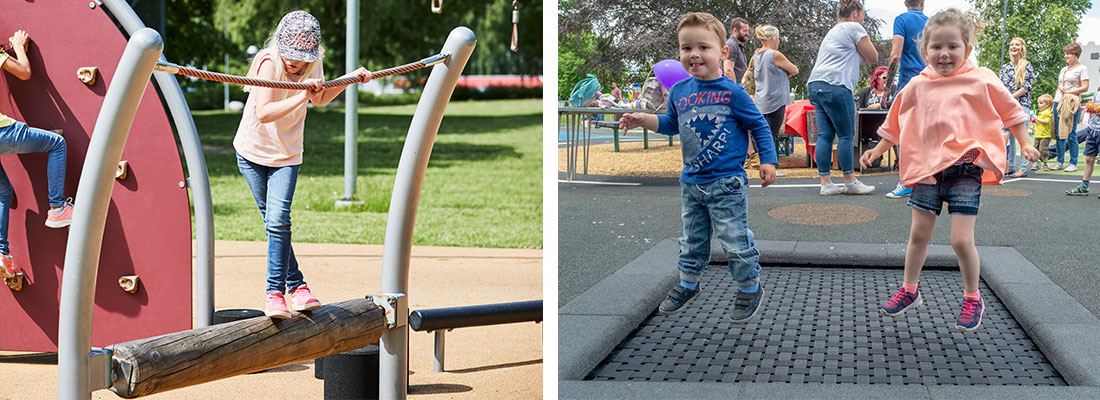
Walking, running and rolling
Provide opportunities for children to play with friends and join in games while building endurance, increasing muscle tone and mastering dynamic balance.
Try to leave some space where children can play games such as tag, or adding a track using a design in the surfacing. Other elements that can be included are running obstacle courses or mazes which are wide enough for someone in a wheelchair to easily manoeuvre through the space. You can also think about creating a path that rises and falls along its length for lots of fun and to build strength.
Movement experienced from a wheelchair or other aid
Enable children using wheelchairs to play equally with friends and to experience a motion that stimulates their vestibular system without leaving the chair.
It’s important to try and provide a piece of equipment that moves the child and their wheelchair, it should also be a social experience where more than one person can play on it at a time.
A great example of this is our Spinmee Inclusive Roundabout.
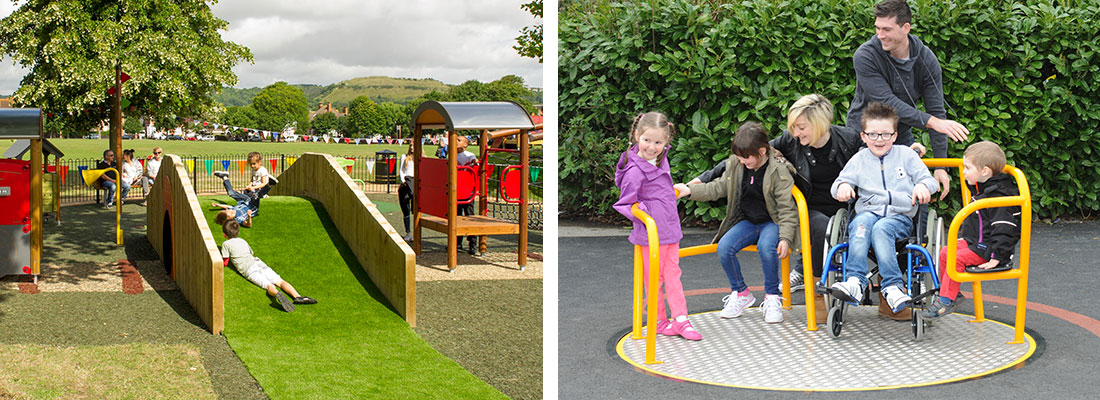
Sensory Play Experiences
As well as physical experiences, inclusive playgrounds should offer children of all abilities a sensory play experience. This includes, tactile, auditory, visual, interaction with natural features and cosy places.
Tactile experiences
Provide children with an enjoyable experience in which they exercise and develop their sense of touch.
Give children the opportunity to feel several of the following textures:
- Smooth – materials are free form projections or unevenness. This could be metal poles, metal slides, mirrors, etc.
- Soft – examples of this include grass, rubber, fabric, etc.
- Hard – a solid and firm material to the touch. For example, rocks, metal, etc.
- Rough – a coarse material with projections, irregularities or breaks. Examples include boulders, rocks, rope, etc.
- Grainy – the material has a granular texture. Such as sand, dirt, rocks or boulders, etc.
- Uneven – bumpy, not level or flat. For example, a slide with bumps built in, textured paths, etc.
Provide opportunities for children to have their full body involved in the tactile activity, for example, rolling down a hill, putting sand or water all over themselves.
Pathways with undulated and/or have texture built into them provides a fun wheeled play experience.
Auditory
Assist the development of the auditory system by including play features that appeal to the auditory sense.
This can be achieved by equipment that creates a sound or enables a child to hear their friend talking from a distance, such as the Talk Tubes. Other ways to help develop the auditory system are with outdoor musical instruments, generating sound by pushing a button in a play equipment, entering an area to create a sound, or walking across an equipment to create the sound.

Visual experiences
There should be features and equipment in the play space that are pleasing to the eye, surprising and delightful and that assist the development of sight and the visual sensory process.
Consider play panels that invite children to trace, track, or match as this also helps develop their visual system.
Consider planning with colour and aesthetics in mind, introducing visually pleasing qualities such as colour and pattern, contrasting colours, sculptures, flags and paving.
Many other ways to help children improve their visual sensory system have already been addressed in the play value sections above.
Interaction with natural features
It’s important to allow children to engage with nature to stimulate many different types of creative, imaginative and social play, and provide a wide-range of health and well-being benefits.
Playgrounds are not only about play equipment, they are also about including natural features such as trees, shrubs, grasses, bark, soil, sand, water and rocks. Planting items that encourage birds, small mammals and insects are also great at getting children to engage with nature.
Including natural features throughout the play space provides a great sensory experience.
Cosy places
Provide at least one location within the play space where a child can go to feel alone, relax and de-stress; it can also be used for social, imaginative or role play.
The play piece should feel enclosed, but still enable the parent or carer to see the child, examples include an area under a multi-play structure, a playhouse, a tunnel with a window, etc.
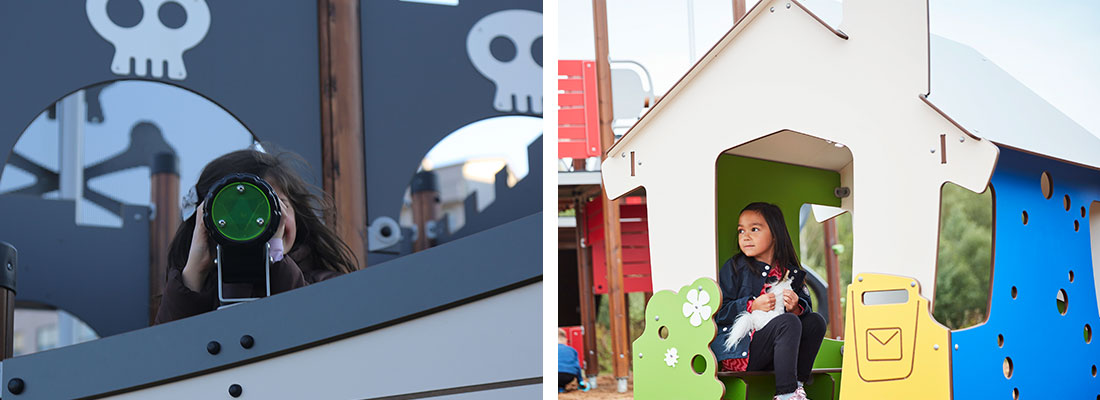
Social Play Experiences
A playground should give children the opportunity to take part in social play and interact with other children. In this section we will look at cooperative play, social interaction, dramatic and imaginative play.
Cooperative play and social interaction
Give children the opportunity to play with each other by providing equipment that requires two or more people to operate it, such as seesaws, or equipment that will do additional things when more than one person is playing with it.
Enable children to experience the social side of playing with others, make new friends and enjoy the company of temporary playmates by including features such as basketball hoops, seesaws, etc. designed to be played by multiple players.
Other social features include water, sand and nature play, as well as providing group seats, such as our Meeting Points.
Provide areas where children can watch and copy the actions of other children, so they can learn from each other and enjoy each other’s company.
Dramatic and imaginative play
Dramatic play provides children the opportunity to use their language, cognitive and social skills. Playgrounds should give children the chance to create play “themes” and act them out by participating in various roles that are spontaneous, child-initiated and open-ended.
Think about using a mixture of abstract and realistic play equipment and features, for example, themed structures, a stage, a playhouse, etc.
Furthermore, if possible, look at including props and loose parts which are easy to manipulate for creative play and do not require great physical strength or fine motor skills.
Loose parts can be natural and/or synthetic materials that can be moved, carried, combined, redesigned, taken apart and put back together in multiple ways, examples include, sand, earth, water, twigs, leaves, building blocks, props, cardboard boxes, movable game or sport materials, etc.
These types of materials allow children to manipulate and use them as they wish in order to change their environment and provide opportunities for social, imaginative and creative play experiences.
Learn more on designing a themed playground

Inclusive Pirate Themed Playground, Burgos, Spain
HAGS designed and developed an inclusive playground in the city of Burgos for children of all abilities to enjoy, creating a comfortable play area for both children and parents.
Read MoreInclusive Tree House Themed Playground, Sweden
A fantastic inclusive playground in the city of Uppsala, Sweden, featuring a tree house-themed customised UniPlay unit.
Read MoreInclusive Playground in Madrid, Spain
This new playground in the neighbourhood of Orcasitas in Madrid was initiated by the Government Department of Environment and Mobility who wanted a unique play area that was inclusive and accessible
Read MoreSpecial Educational Needs School, UK
Kingsland Primary School is an outstanding rated Special Educational Needs school in Yorkshire, UK, which caters for children with a range of learning disabilities. They asked HAGS to design and build inclusive play areas for each of their two sites.
Read More
HAGS Aneby AB
Grännavägen 7 578 33 Aneby
Contact Us
If you have questions or would like to know something about our products, you can contact us by phone, fax, email or directly on our website. If you do not know who at HAGS you should talk to, or if you would like to come in contact with a specific person at HAGS, you are welcome to call our switchboard to get connected to the right person.



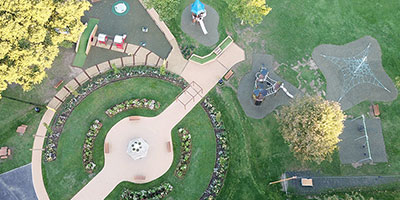
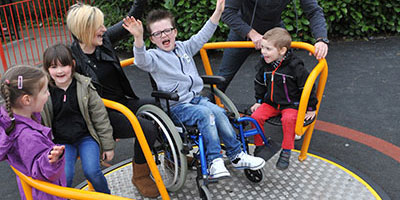
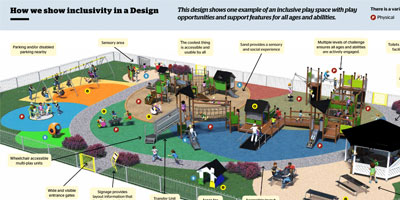
.jpg)
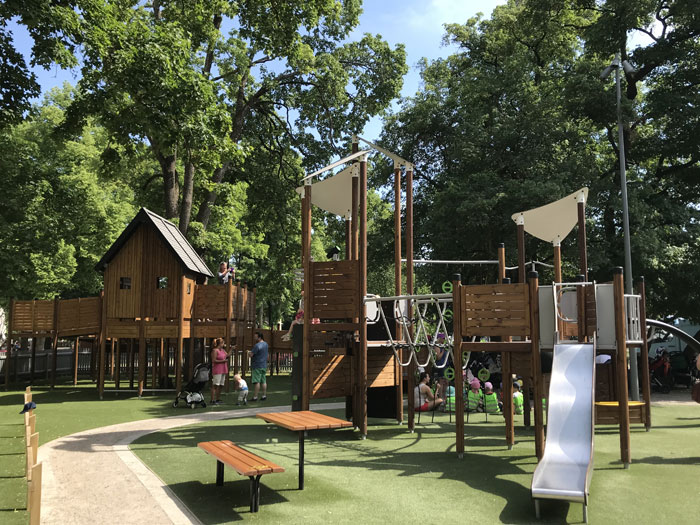
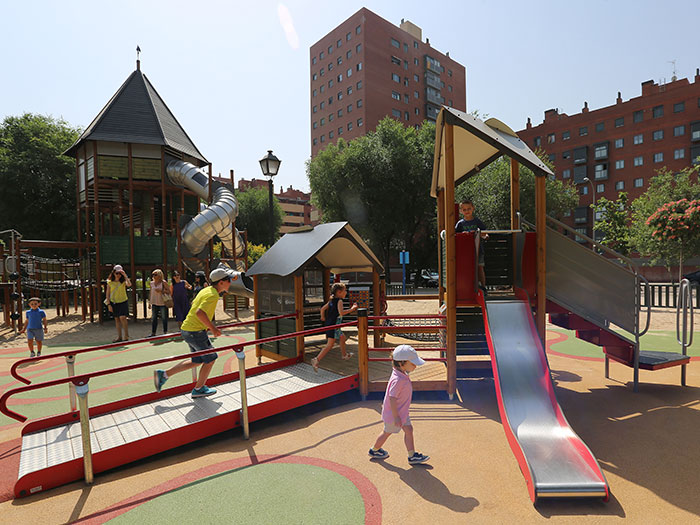
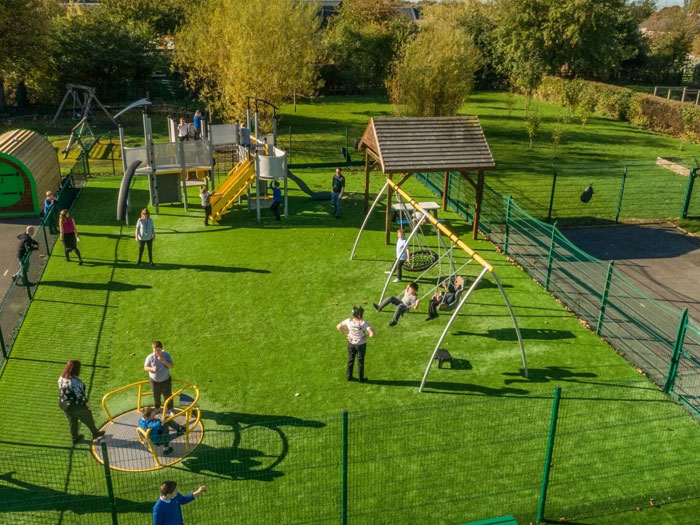




































































Follow HAGS: